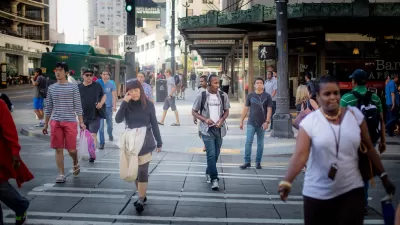John K. McIlwain breaks down the recent explosion in the "65-or-better" population – and what it means for urban regions.
The last ten years have seen staggering growth in the population of senior citizens in the United States. According to the U.S. Census Bureau, seniors increased their ranks by 20% from 2000 to 2010 – twice the rate of the general population – and that rate is expected to more than double over the current decade.
And while the aging of the American population has figured prominently in the national political discourse, McIlwain suggests that it is poised to have an even greater impact at the local level.
"Seniors are wealthier than any other age group despite the recession, their rates of homeownership are higher, they support the local economy, they pay local taxes, and they have a very low crime rate," McIlwain explains. "While they are politically active, their interests often clash with those of young families concerned about spending on schools and roads."
Even among urban regions, population trends for seniors vary widely. Seniors in some metro areas, like Raleigh, grew at triple the national average, while many others saw an exodus of older people.
In noting that some of their migration was directed toward suburban town centers (in addition to traditional urban centers), McIlwain suggests that the political and market influence of those seniors moving to "boutique cities" may reflect those of their urban dwelling cohorts.
In general, however, the population of seniors in larger metropolitan regions grew faster than it did in their corresponding urban centers. According to McIlwain, "There are still more empty nesters who have stayed put in the suburbs-'aging in place,' as it is now called...So, despite an increase in urban living among seniors, other moves (or nonmoves) by seniors over the past decade have been more significant."
FULL STORY: Seniors—In Which Metro Regions Are They Living?

Alabama: Trump Terminates Settlements for Black Communities Harmed By Raw Sewage
Trump deemed the landmark civil rights agreement “illegal DEI and environmental justice policy.”

Planetizen Federal Action Tracker
A weekly monitor of how Trump’s orders and actions are impacting planners and planning in America.

The 120 Year Old Tiny Home Villages That Sheltered San Francisco’s Earthquake Refugees
More than a century ago, San Francisco mobilized to house thousands of residents displaced by the 1906 earthquake. Could their strategy offer a model for the present?

In Both Crashes and Crime, Public Transportation is Far Safer than Driving
Contrary to popular assumptions, public transportation has far lower crash and crime rates than automobile travel. For safer communities, improve and encourage transit travel.

Report: Zoning Reforms Should Complement Nashville’s Ambitious Transit Plan
Without reform, restrictive zoning codes will limit the impact of the city’s planned transit expansion and could exclude some of the residents who depend on transit the most.

Judge Orders Release of Frozen IRA, IIJA Funding
The decision is a victory for environmental groups who charged that freezing funds for critical infrastructure and disaster response programs caused “real and irreparable harm” to communities.
Urban Design for Planners 1: Software Tools
This six-course series explores essential urban design concepts using open source software and equips planners with the tools they need to participate fully in the urban design process.
Planning for Universal Design
Learn the tools for implementing Universal Design in planning regulations.
Clanton & Associates, Inc.
Jessamine County Fiscal Court
Institute for Housing and Urban Development Studies (IHS)
City of Grandview
Harvard GSD Executive Education
Toledo-Lucas County Plan Commissions
Salt Lake City
NYU Wagner Graduate School of Public Service





























